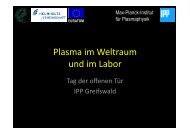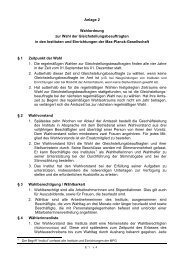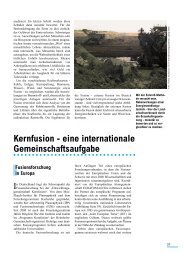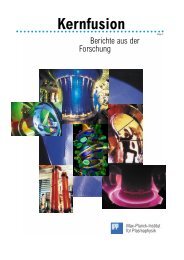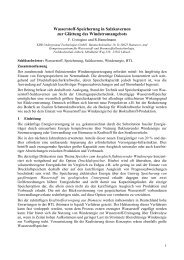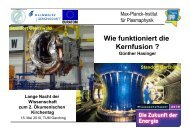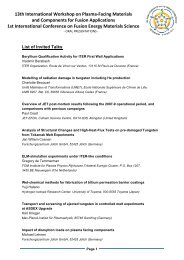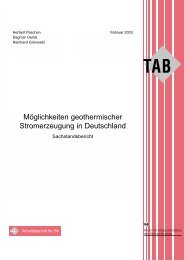IPP Annual Report 2007 - Max-Planck-Institut für Plasmaphysik ...
IPP Annual Report 2007 - Max-Planck-Institut für Plasmaphysik ...
IPP Annual Report 2007 - Max-Planck-Institut für Plasmaphysik ...
Create successful ePaper yourself
Turn your PDF publications into a flip-book with our unique Google optimized e-Paper software.
an admixture of 10 % D 2 ) were performed. The start-up<br />
procedure was slower than usual, because of the technical<br />
constraints (due to the missing fly-wheel generator EZ4)<br />
and a less reliable plasma breakdown and current ramp-up<br />
phase compared to boronized conditions. However, after<br />
about 20 plasma discharges the current flat-top could be<br />
reached and it took only about 5 more discharges to obtain<br />
the first H-modes.<br />
He Conc. (Div) (%)<br />
H98<br />
6<br />
4<br />
2<br />
0<br />
1.2<br />
0.8<br />
0.4<br />
0.0<br />
21700 21800<br />
shot<br />
21900<br />
Figure 2: Temporal evolution of the divertor He/D influx ratio (top) and the<br />
ITER H factor H98 (bottom) in I =0.8 MA, P =7.5 MW discharges. The<br />
p NBI<br />
vertical dashed line denotes the discharge from which on He-glow was no<br />
longer performed.<br />
Figure 2 shows the temporal evolution of the divertor He concentration,<br />
and the ITER H factor H98 during I p =0.8 MA,<br />
P NBI =7.5 MW discharges, starting with # 21700 (the re-commissioning<br />
started around # 21600, but mostly technical trials<br />
were performed and only about 100 s of plasma operation<br />
were accomplished in this initial phase). Although the H<br />
concentration was already quite low (~10 %) and the total<br />
radiation was in the range of 50 %, the confinement remained<br />
at H factors between 0.6-0.8. In parallel, an increasing amount<br />
of He was observed in the plasma discharges, obviously<br />
due to the He overnight glows and the inter-shot He glow<br />
discharges (5 min. duration). Since it is known from experiments<br />
and code calculations that He is de-enriched in the<br />
divertor by a factor of 0.25-0.35, the He concentrations in<br />
the main plasma could have reached values up to 20 %,<br />
consistent with exploratory CXRS measurements. The storage<br />
in and the strong release of He from W surfaces was already<br />
ASDEX Upgrade<br />
6<br />
known from the previous campaign and from accompanying<br />
laboratory experiments, but no strong influence on the confinement<br />
was expected. However, after omitting He glow<br />
completely and performing 3 minutes of D 2 glow only after<br />
disruptions, the He concentrations decreased rather quickly<br />
and, concomitantly, the confinement increased (figure 2,<br />
bottom). Edge density and temperature measurements suggested<br />
that a weak edge transport barrier was at least partly<br />
responsible for the lower confinement with high He content.<br />
Additionally, after the initial conditioning phase it was<br />
found, that inter-shot glow discharges are much less important<br />
for plasma ramp-up and density control, than they have<br />
been with graphite PFCs.<br />
Astonishingly, similar levels of oxygen as in previous campaigns<br />
have been achieved after the initial conditioning<br />
phase with the full W wall without boronization. Post<br />
mortem analysis of the PFCs revealed very low C deposition<br />
at remote areas in the divertor (see MF section), which<br />
reflects the strongly reduced primary C sources. However,<br />
neither C influx measurements at the central column nor<br />
CXR spectroscopy show this strong reduction yet. Typical<br />
values are several 10 20 /s for the gross C-influx and 0.3 % for<br />
the edge C concentration. The reason for the persisting (low)<br />
C influx and content is not yet completely understood, but in<br />
principle it can be explained by the remaining small C<br />
sources and the observed strong C recycling. Therefore, all<br />
PFC has been thoroughly cleaned to start the 2008 campaign<br />
with pure W surfaces.<br />
2.3 Tungsten Influxes<br />
Special emphasis is given to the determination of the tungsten<br />
influx in order to elucidate the details of the erosion processes<br />
and to assign them to specific plasma scenarios. Figure 3<br />
shows the temporal evolution of the W influx at the low<br />
field side limiters, the central column and in the divertor in<br />
an I p =0.8 MA, n e ~7.5⋅10 19 /m³ discharge with continuous<br />
NBI and ECRH as well as alternately switched ICRH.<br />
Simultaneously, the outer radius of the plasma was varied.<br />
The W fluxes from the divertor and the central column (HS)<br />
presented in the bottom part of the figure were calculated<br />
assuming toroidal symmetries. The W influx at the low field<br />
side (LFS) ICRH limiter (W L34 ) increases immediately by<br />
almost one order of magnitude as soon as the corresponding<br />
antenna is powered and it increases generally for larger plasma<br />
radii leading to a smaller gap between separatrix and LFS<br />
limiters. From the temporal behaviour of c W it can be concluded<br />
that the divertor W source, although it is the largest<br />
one compared to the sources from the other areas has only a<br />
minor impact on the W contamination in the plasma. This is<br />
in line with earlier investigations comparing discharges with<br />
the upper W divertor with ones using the lower graphite<br />
divertor and dedicated experiments with W injections at the<br />
mid-plane and in the divertor.




